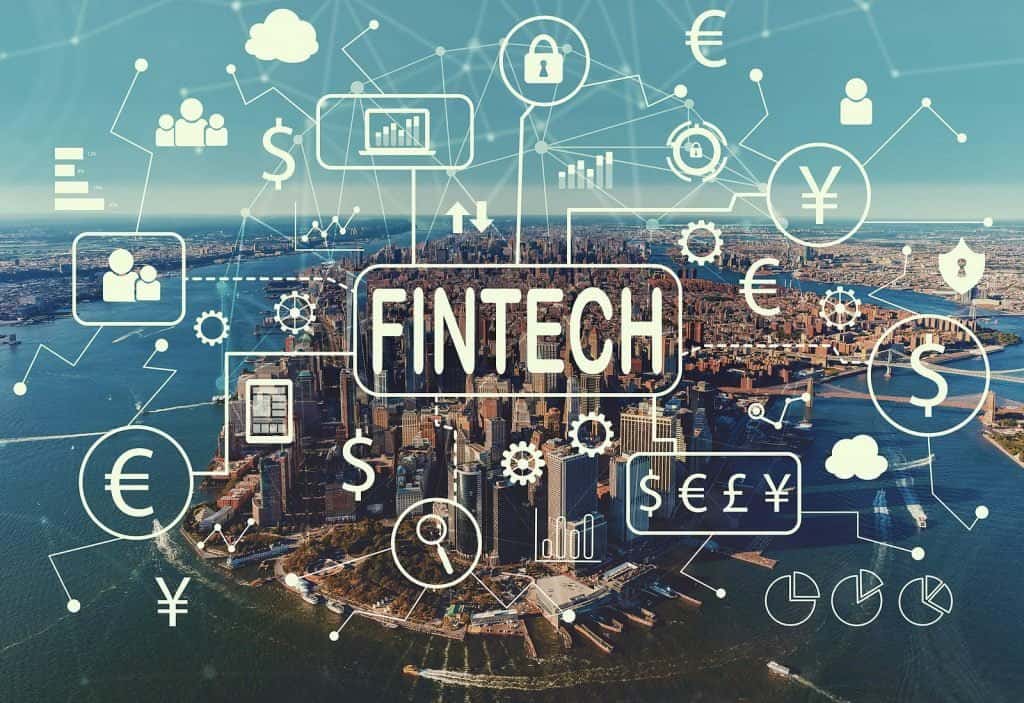What is Fintech? And what does Fintech stand for? Well, Fintech is an amalgam of the words “financial technology.”
Table of Contents
ToggleIt describes a set of hardware, software, and processes designed to improve and automate the delivery and use of financial services.
It’s not a new concept, as such. Past innovations like the adding machine and double-entry bookkeeping fit the Fintech definition, and have been around for decades.
But what is financial technology, in the context of the present day? At the beginning of the 21st Century, banks and finance houses got their introduction to financial technology of the digital age, through the systems and software powering their back end operations.
These systems were employed by financial institutions to automate banking services, insurance, trading, and risk management.
With the development of cryptocurrencies like Bitcoin and its associated blockchain technology, the Fintech meaning took on a broader scope and greater relevance to the public at large.
Financial technology has been engineering a shift to more consumer-oriented services, with Fintech introducing a variety of innovations into personal and commercial finance.
Fintech currently describes a variety of financial activities, including money transfers, online payments, depositing checks with your smartphone, applying for credit without having to visit a bank, raising money for a business, or managing your investments.
And the fusion of words with “technology” has expanded to include a number of new offerings that include insurance (InsurTech), wealth management (WealthTech), lending (LendTech), and regulatory compliance (RegTech).

Fintech History & Revolution
Finance has always shaped technological developments, with the two sharing a long and symbiotic relationship.
The first Industrial Revolution, for example, was facilitated by the provision of capital from financial intermediaries during the 18th and 19th centuries.
In fact, financial technology or Fintech history spans a period of well over 150 years. Scholars have identified three waves of technological disruptions in finance.
- Fintech 1.0: The first wave of technology was initiated by the completion of the first transatlantic telegraph cable in 1866. During this period, finance gradually shifted from analog to digital.
- Fintech 2.0: Development of the automated teller machine (ATM) in 1967 prompted a second wave of technological innovations in financial services.
- Fintech 3.0: We are currently witnessing the third wave of increasing technological influence in finance. This is going hand in hand with the emergence of new actors and new channels for finance provision.
This third wave of the Fintech revolution (a process which has been unfolding for over 150 years) is likely to have lasting effects on the financial services sector for many reasons.
For one, the current pace of innovation is quicker than in previous decades, as is the rate of adoption.
ATMs gained popularity over two decades, while internet and mobile banking have achieved widespread use over progressively shorter intervals.
The demographic shift has given rise to a generation of digital natives whose technological proficiency, behavior, and demand for digital services in everything are fueling Fintech innovation.
In addition, Fintech has become a vehicle for financial inclusion, with tremendous growth potential.
By bringing the savings of poorly served and “unbanked” individuals into the financial system and increasing inclusion, Fintech is enabling economies to more efficiently channel savings into investments in industry, infrastructure, and human capital.
In this way, Fintech has the potential to increase economic growth in both emerging and major economies, improving capital allocation and increasing efficiency.
As the Fintech History & Revolution train rolls on, a number of possibilities are emerging to describe the future roles of Fintech and traditional financial services.
Banks Become Better: Traditional banks digitally transform and modernize themselves to retain the customer relationship and core banking services, using technology to change their current business models.
New Banks Emerge: Existing financial institutions are replaced by new technology-driven banks (“neo-banks”), with full-service digital banking platforms.
Banking Becomes Distributed: A digital customer interface becomes the platform for modular financial services offered by a range of providers.
Banks Fade Into The Woodwork: Building on the digital customer interface scenario, banks simply become service providers, leaving the management of the direct customer relationship to Fintech and big tech companies who use front-end customer platforms to offer a variety of financial services.
The Customer Rules, With No Intermediary: At this stage, banks become irrelevant because consumers interact directly with individual financial service providers. An early example of this is peer-to-peer lending platforms, where individual customers can directly take on the role of the lender or borrower.
Real-World Examples of Fintech
In the real world, Fintech examples cover a broad spectrum, ranging from household names on the internet to specialist services known only within banking and finance circles. They cover all aspects and categories of financial technology.
Members of the general public are most likely familiar with one form of Fintech through mobile payment platforms such as Google Wallet, PayPal, Apple Pay, the mobile payment app Venmo, or China’s Alipay (a division of Alibaba).
These applications and gateways allow users to send and receive money via their smartphones or the internet with minimal transaction fees and enable customers to carry out banking activities without physically visiting a bank.

Cryptocurrency, digital units of trade that do away with the need for cash or physical banknotes, has entered the mainstream consciousness (not always for good reasons), through the popularity of cryptocurrencies like Bitcoin and Ethereum.
Despite the often high market valuation of these currencies, they’ve gained just as much notoriety from being the payment method of choice for cyber-criminals and extortionists who hack user accounts or distribute ransomware.
Internet and social media users will also recognize Fintech in the form of crowdfunding platforms such as Kickstarter, GoFundMe, or Patreon.
These peer to peer finance platforms enable individuals, entrepreneurs, and early-stage businesses to raise funds from fellow users of the platform, and from all over the world, without having to go through the negotiations and bureaucratic practices of a formal lending institution.
Insurance technology or InsurTech has been disrupting the industry, and extending coverage to people who may not have been eligible for it in the eyes of more established insurance firms.
The insurance startup Oscar Health has been serving this function for consumers in the health insurance sector, for example.
In the auto industry, technologies like telematics (in-car black boxes) are assisting young and less experienced drivers in reducing the size of their insurance premiums, with some InsurTech platforms enabling drivers to adopt insurance plans with charges based purely on the number of miles they drive.
Personal finance for everyday consumers now benefits from the emergence of budgeting apps, which automatically track income, expenditure, and other financial activities. Mint, Acorns, and PocketGuard are examples.
Some Fintech startups provide customers with free credit reporting, including updated credit scores and insights.
Companies such as Credit Karma also enable customers to check and compare different loans and credit card offers.
Acorns and Robinhood are part of the growing ecosystem of digital financial advisors now offering potential investors an opportunity to benefit from market analysis and economic assessments based on intelligent algorithms.
Stock-trading apps help investors decide on which stocks to buy or sell without having to monitor stock exchanges like the NYSE or Nasdaq. And Robo-advisor services like Charles Schwab, Wealthfront, Betterment, Ellevest, or Vanguard can analyze investment and finance management options 24/7, providing algorithm-based asset recommendations.

As established financial institutions rise to the challenge posed by financial technology to their traditional dominance, there’s a growing number of Fintech examples in banking.
Banks and other institutions are looking to digital technology to enhance the customer experience, streamline operational efficiencies, reduce fraud, and improve security.
One way of enhancing the customer experience that’s being adopted by banks is the use of artificially intelligent virtual assistants, as an additional element to their mobile banking offerings.
For example, Erica (whose name derives from the second half of the word “America”) is a mobile assistant application from Bank of America that lets users view their bills and payments, transfer money, get regular FICO Score updates, and receive breakdowns of recurring monthly payments.
Capital One’s intelligent assistant Eno (that’s “One,” backward) lets customers use the bank’s smartphone message application to text questions, get fraud alerts, and take care of tasks like paying off credit cards, tracking account balances, viewing their available credit, and checking transactions.
Users can ask Eno basic questions and find quick information without having to log into their mobile app -and the platform even uses emojis to communicate, just like a human.
In an effort to make mobile and online banking less treacherous for customers and financial institutions alike, Fintech companies are offering mobile risk and fraud solutions for industries like banking, insurance, and eCommerce.
The software company Feedzai for example offers end-to-end anti-fraud and anti-money laundering solutions to retail banks.
The platform harnesses machine learning and risk management tools, to provide banks and their customers with multi-channel fraud protection covering issues such as account takeover, transaction fraud, and the verification of new accounts.
The security platform InAuth helps banks to secure their mobile applications so that customers are less susceptible to fraud.
The platform offers tools like two-step authentication, device integrity screening, geo-location searches, and transaction monitoring to increase security, reduce losses due to fraud, and enhance the mobile banking experience.

Another aspect of Fintech in the banking sector is the emergence of “neo banks” -digital finance companies that provide essential banking services, without having any physical branches.
By offering perks such as fewer fees and greater transparency, these digital platforms are learning the lessons from what traditional banks have done in the past to discourage and drive away consumers.
One example is the San Francisco-based Varo -an all-in-one mobile banking platform offering services that range from deposits and savings accounts to cash flow projections and in-app budgeting tools.
The platform charges no fees for monthly service, foreign transactions, or for using any of its 55,000 ATM locations.
Simple in Portland, Oregon offers banking and budgeting services on a mobile platform that also allows users to log their recurring expenses and automatically set aside enough money every month for essential purchases.
Shared accounts for couples enable each partner to retain their individual accounts while collaborating on financial projects at their own discretion.
On the flip side of the coin, financial technology is enabling traditional institutions to offer services that go beyond conventional banking, allowing them to compete directly with more established Fintech platforms.
For example, cryptocurrencies such as Ripple have emerged to give banks access to blockchain technology without their needing to invest in research and specialized infrastructure to support the upgrade.
Many banks have constructed their own blockchains, retaining control over the monetary system, and giving rise to a new form of the digital currency known as Central Bank Digital Currencies (CBDCs).
Unlike cryptocurrencies, CBDCs are centralized, with issue controlled by a central organization rather than a mathematical algorithm as in the case of Bitcoin.
Some banks have also adopted new compliant forms of cryptocurrency known as security tokens, which follow the strict securities guidelines put in place by global currency trading authorities.
These security tokens enable organizations to implement blockchain-based crowdfunding strategies without running the risk of conducting an unregulated securities sale.

Why Fintech Is Important?
Why do we need Fintech? Compared to corporate and retail banks, the solutions offered by Fintech are often cheaper, quicker, and more efficient, in many cases enabling consumers to avoid the transaction fees associated with the online services that traditional banks have put in place for accessing accounts and transferring money.
People without personal access to banking, or who live in countries without a traditional banking infrastructure, can use Fintech to get the financial support they need online.
In many cases, Fintech is actually safer than traditional banking, which has been notoriously slow in adopting cybersecurity.
By contrast, Fintech is founded on digital technology, and often has security tools and best practices baked into the system, from the outset.
Besides making life easier for consumers, Fintech solutions also give small to medium-sized businesses (SMBs) greater access to banking, lending, and finance options that may have been denied to them by traditional channels.
Such services would include peer-to-peer or marketplace lending, financing for a merchant, invoice, and eCommerce activities, online supply chain finance, and financing for online trade.
For larger-scale enterprises, Fintech offers opportunities to expand their services and operate at higher efficiency, with options such as electronic invoicing, and the availability of open APIs (Application Programming Interfaces).
Regardless of the scale of an organization, Fintech can also play a role in the aggregation, analysis, and management of data.
Competition between Fintech and traditional financial services has led to the improvement of the latter, as banks and finance houses upgrade or replace their legacy systems with modern infrastructure and innovative new solutions, which can offer greater benefits to their consumers.
Why is Fintech growing? A simple answer is that financial technology is continuing to effect major changes in asset management, business and personal loans, fundraising, money transfers, and the ways that people invest.
All while, disrupting the way that businesses in all sectors operate, and increasing the options and opportunities available to individual consumers.
As a result, global investment in financial technology has exploded in recent years, growing Fintech into a multi-billion dollar industry.
Venture capitalists are throwing millions of dollars into a market still primarily dominated by startups.
But at the same time, many traditional financial institutions are creating their own Fintech services or partnering with established financial technology providers to bring services to their clients.
With increasing numbers of businesses adopting digital payment systems, the demand for Fintech solutions is growing, and fueling growth in the market.
And as Fintech systems increase their capacity to enhance trade accuracy, speed up settlement processes, and reduce risk, there’s increasing investment in technologies like blockchain.
Even in highly regulated environments like the European Union, Fintech operators are managing to cope with regulations and legislative amendments, and are developing software for US, European, and international banks.
Fintech Categories
Broadly speaking, there are two main categories of Fintech: financial services providers and financial services software providers.
Financial Service Providers
Financial services providers in the Fintech sector include digitally native consumer-direct banks, lenders, wealth managers, insurance firms, and other finance companies.
Within this category, the new breed of emerging companies is often referred to as challenger banks, neobanks, or simply startup banks.
These companies typically start by offering a single budgeting, saving, borrowing, or investment product, before expanding into other banking services once they acquire a substantial customer base, and establish some pulling power.
Financial Services Software Providers
Financial services software providers consist of the business-to-business (B2B) software, tools, and technology platforms that power banks, lenders, wealth managers, insurance firms, and other finance companies.
These two main Fintech categories may be further subdivided into four broad categories of users, namely, business-to-business (B2B) Fintech for banks, B2B for the business clients of financial institutions, business-to-consumer (B2C) for small businesses, and Fintech for consumers.
Delving deeper into the financial services industry, there are several categories of business to which Fintech is currently being applied.
Blockchain and Cryptocurrency
Though still in its early stages of evolution, the distributed ledger or blockchain is making it possible for financial institutions to provide more secure, private, and transparent ways of tracking the complete life cycle of financial transactions.
For some years now, blockchain has been the foundation for cryptocurrency—a form of digital or virtual money which does away with the need for physical banknotes or coins.
Cryptocurrency systems and exchanges like Coinbase and Gemini are based on blockchain, and connect users to buying or selling cryptocurrencies such as bitcoin or litecoin.
Blockchain technology maintains records on a network of computers but has no central ledger.
The data structure that holds transactional records on a blockchain helps to preserve security, transparency, and decentralization.
Each transaction is encrypted, and the chances of successful cyber-attacks are relatively low.
This enables blockchain-powered trading platforms to act as a medium for managing smart contracts, Proof-of-Work, and Peer-to-Peer transactions.
It also introduces the possibility of open banking, an idea which proposes that third-parties should have access to bank data, in order to build applications that create a connected network of financial institutions and third-party providers.

Budgeting Apps
Budgeting apps eliminate the need for consumers to manually file checks, or navigate spreadsheets to keep track of their finances.
This class of Fintech enables users to monitor their income, monthly payments, expenditures, and other aspects of their financial existence from a single mobile app.
Consumer Banking Technology (BankTech)
This class of Fintech uses digitized platforms to offer banking solutions and finance products similar to those available at traditional banking institutions -and solutions that brick and mortar banks can’t offer made viable through digital technology.
Properly implemented, BankTech provides a better customer experience, less friction in operations, and reduced costs, when compared to traditional banking.
Crowdfunding Platforms
Crowdfunding platforms allow internet and mobile app users to send or receive money from other users on the platform, bypassing more conventional ways of sourcing funds like asking a bank or finance company for a loan.
Crowdfunding allows individuals and businesses to appeal directly to investors for support of a project or enterprise.
And the platforms enable users to aggregate the funding they receive from various sources, in a single location.
Insurance Technology (InsurTech)
Insurance technology or InsurTech aims to use technology to simplify and streamline the insurance industry.
Its scope includes everything from car insurance to home insurance and data protection, changing the way that consumers buy and use insurance.
Using technology, for example, insurance premiums are calculated automatically. And products like telematics (black boxes) are now being offered to young or inexperienced drivers to allow them to reduce their car insurance premiums.
Fintech innovations have been improving efficiency, reducing costs, improving risk assessment, and delivering better customer experience throughout the insurance industry.
Lending Technology (LendTech)
The focus of lending technology or LendTech is on using technology to offer consumers lending solutions through more accurate and streamlined processes.
Smart LendTech systems can use Artificial Intelligence (AI) and Machine Learning (ML) algorithms to process and verify identity credentials and ensure error-free results.
Predictive analytics algorithms can forecast income prospects, assess a borrower’s track record, appraise their collateral value, and make predictions about changes in borrower behavior.

Payment Technology (PayTech)
Payment technology or PayTech concerns itself with managing assets and processing various payment transactions securely and efficiently.
To this end, the development and integration of digitized processing applications and diverse processing networks are combining with consumer-level technology such as wearables and smart devices, to facilitate better digital connectivity and customer identity protection.
Mobile Payments
An offshoot of payment technology, mobile payment technologies such as mobile wallets, and integrated payment solutions provide security and ease of use, helping to improve the consumer experience.
Personal Finance Technology (WealthTech)
By focusing on the improvement of wealth management and retail investment services through the use of technology, personal finance technology or WealthTech simplifies the investment process, enabling investors to manage their portfolios in a more efficient and automated manner.
WealthTech solutions can enhance existing investment solutions or create new ones.
Regulatory Technology (RegTech)
Regulatory technology or RegTech was introduced in 2015 by the Financial Conduct Authority as a subset of Fintech, whose focus is to use innovative technology to aid better regulatory compliance, and the delivery of easy-to-integrate, secure, and cost-effective regulations.
Its aim is to standardize and facilitate transparent regulatory processes that automate the entire compliance system.
Besides compliance management, RegTech finds applications in regulatory reporting, risk management, and transaction monitoring.

Robo-Advisors And Stock-Trading Apps
Robo-advisors use algorithms to automate investment advice through algorithm-based asset recommendations and portfolio management, thereby lowering its cost and increasing its accessibility.
Robo-advisors can automatically generate portfolios for customers, and allow users of all age groups to engage in investment activities at low fees, and with minimal effort.
With the development of more advanced technologies that can analyze various portfolio options 24/7, financial institutions have begun to offer online Robo-advising services.
Stock-trading apps provide a similar function for potential investors, offering algorithm-derived advice on the best options for buying and selling.
Trading Technology (TradeTech)
Trading technology or TradeTech implementations facilitate and support cross-border trading through the use of IT systems in supply chain finance and asset distribution platforms.
The aim is to reduce the information costs of international trade, facilitate trade finance, and increase the transparency of trading operations for businesses and consumers.
Advantages & Disadvantages
As with any technological platform, in discussing Fintech, advantages, and disadvantages co-exist.
In this section, we’ll be looking at Fintech advantages and disadvantages as they apply to the sector in general, and more specifically, as they affect the banking industry.

Advantages of Fintech
Savings in time and money are among the principal advantages of Fintech. Automation and ease of access to Fintech platforms allow financial procedures to be carried out much faster than through traditional channels.
Fintech also provides greater flexibility for operators and consumers, providing easier ways for users to perform all kinds of operations.
This increases process efficiency and throughput for the Fintech operator and saves time and hassle for the consumer.
The fact that many Fintech solutions do away with the transaction fees typically associated with banking and finance provides significant monetary savings for the customer.
And for the financier, the increased patronage and streamlined operations resulting from Fintech adoption translate into greater earnings for the enterprise.
By lowering the bar in many cases and providing an expanded range of financial products, Fintech is making the financial sector more inclusive.
“Unbanked” individuals across the globe now have access to financial services, and customized solutions geared to a consumer’s personal needs are being continuously developed.
With the application of new technologies, many Fintech platforms also offer greater transparency into the inner workings of business management and financial offers.
Improved methods of data gathering, management, and analysis are among the benefits of Fintech for banks and their customers.
Intelligent analytics tools now enable users to discover patterns of abuse or suspicious activities with a scale, speed, and precision that makes it easier to bring bad actors in the financial system to book.
Though increased security and greater governance through in-built technology are often Fintech benefits, challenges, and solutions to the issues they produce are still a consideration.
When it comes to mobile banking, payment apps, and Fintech in general, security and privacy are major concerns.
The automation of processes and movement of information through digital platforms extends an invitation to hackers and cybercriminals, which can potentially lead to the theft or online exposure of sensitive data.
The 2017 breach of Equifax Inc.’s software platform that gave hackers access to the sensitive personal information of over 143 million Equifax customers in the United States and Canada is a case in point.
Best practices and secure technologies such as biometric and two-factor authentication, data encryption, real-time monitoring, and behavior analysis are some of the tools available for combating these threats.
In a global atmosphere of increasingly tight regulation -and one in which the financial industry is itself strictly regulated -the same restrictions may not necessarily apply to the Fintech sector.
For example, Fintech peer-to-peer payment operators don’t necessarily have to abide by the same rules that a bank offering a similar service does.
At present, organizations working with such operators may have to exercise caution in the way that data and processes are being handled by a third party.
Existing regulations may expand their reach, as more Fintech companies come into the market.
And moving forward, banks and Fintech companies that want to work together will need to find ways of navigating the changing regulatory environment.
At an operational level too, Fintech can prove challenging -especially where emerging and evolving technologies such as blockchain, artificial intelligence, and big data analytics are concerned.
These implementations often require specific expertise, which may not be readily available to an organization, or which may be out of its price range, given the current IT skills shortage and rising salary levels for expert practitioners.
For consumers of Fintech, there’s often a knowledge gap as well. Customers may lack understanding or knowledge when it comes to the benefits offered by a particular platform or application.
This can reduce the uptake or adoption of Fintech services, to the detriment of providers and consumers alike.
Benefits aside, why is Fintech bad in some circumstances? Many Fintech companies offer apps and services to help people save, budget, get low or no-rate loans, and reduce their debt.
For large numbers of people, Fintech has had the effect of “democratizing” finance and making previously unavailable products and services accessible.
However, the world’s poorer population may not be so lucky. When a digital loan is granted through a mobile or online provider, for example, algorithm-based lending makes its decisions from the standpoint of data only.
The result can be a standardization of the assessment process that excludes subjective factors and individual circumstances that may leave candidates without financing, who may otherwise have been given funds after a one-on-one discussion with a human loan officer.
These same standardized methods may also impose repayment conditions that lower-income borrowers are simply unable to meet.
Fintech companies typically have the same motivation as any financial services firm: to make money in the digital economy, that often equates to data, and its accumulation and trade in various ways.
When the customers are economically disadvantaged, there’s a higher probability that their personal and financial information will be of greater value to those in the high technology food chain than any monetary gains they might deliver from their own savings.
This introduces the danger that for the world’s poor, Fintech may simply introduce new forms of bias, threats to data privacy, security violations, misleading marketing, and even wider systemic risk.

Future of Fintech
Global economic growth, a growing need for loans, financial services, and insurance, and an increasing interest in investments are some of the factors suggesting that the future of Fintech will be a profitable one.
With Fintech developments touching on almost every aspect of life and business, the potential for wealth generation is virtually limitless.
Financial technology continues to disrupt the way that services are consumed and delivered -but Fintech itself is also being affected by external factors that may help to shape its future.
The sharing economy embodied in business models like Uber or Airbnb will likely expand to include the financial services sector.
Decentralized asset ownership and the harnessing of digital technology will make it easier to find suitable matches between providers and users of capital, rather than having to turn to a bank as an intermediary.
At the same time, the commercialization of blockchain technology could make it available as a public ledger that will go on to become an integral part of the technological and operational infrastructure of financial institutions.
With advances in data management and analytics, customer intelligence will become a key factor in determining the revenue growth and profitability of Fintech operators.
Increasing access to data and the drawing of actionable insights from that information will be a differentiator of each platform’s ability to give customers what they actually want.
As Software as a Service (SaaS) offerings increase in sophistication, the public cloud looks set to emerge as the dominant infrastructure model for financial services.
In particular, core service infrastructures in areas such as consumer payments, credit scoring, and statements and billings of the basic current account functions for asset managers will become utilities delivered via the public cloud.
Artificial intelligence and robotics tools are serving as a vehicle for forging alliances between leading financial services and technology companies.
For the future, these organizations are looking to combine capabilities such as social and emotional intelligence, natural language processing (NLP), logical reasoning, self-supervised learning, physical sensors, mobility, navigation, and the identification of patterns, in a push to enhance the customer experience by replacing the bank teller.
At an institutional level, Fintech futures are being forged through the emerging trend of partnerships between financial institutions and Fintech companies.
The main models for these partnerships are Software as a Service (SaaS), referrals, acquisitions or outright purchase, co-branding, Bank-to-Bank, and Fintech integration services.
This trend reflects a view that’s become prevalent in the financial services industry over the last six years -that disruption should give way to collaboration, with banks and Fintech operators working side-by-side as partners toward a common goal.
There are two sides to this trend. On the one hand, in the fallout of the Financial Crisis (2008 – 2009) and the subsequent rise of Fintech as a disrupting force, traditional financial institutions have been scampering to keep up, and to modify their approach to business from a product-centric strategy to one centered on the customer.
On the other hand, despite their appeal to consumers, the overall market share of Fintech in comparison to established institutions has been relatively small, as customers maintain their long-standing relationships with trusted banks while hoping that these older institutions would deliver the latest capabilities that Fintech has to offer.
Moving forward, partnerships will enable traditional institutions to scale quickly while reaching new markets and customer segments.
And Fintech operators will be able to access established customer segments that are loyal to financial institutions and benefit from the bank’s experience of working in a highly regulated environment.





